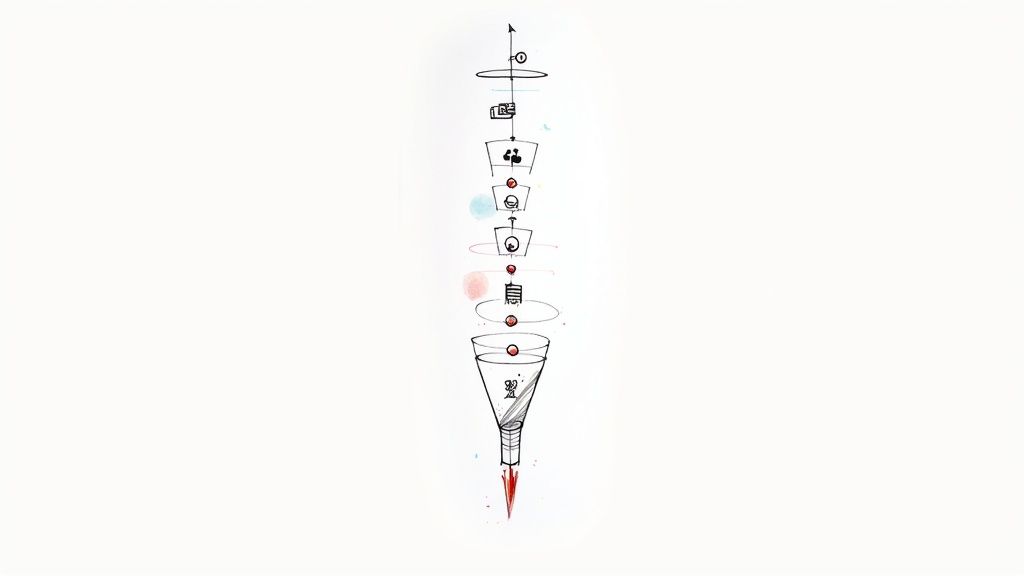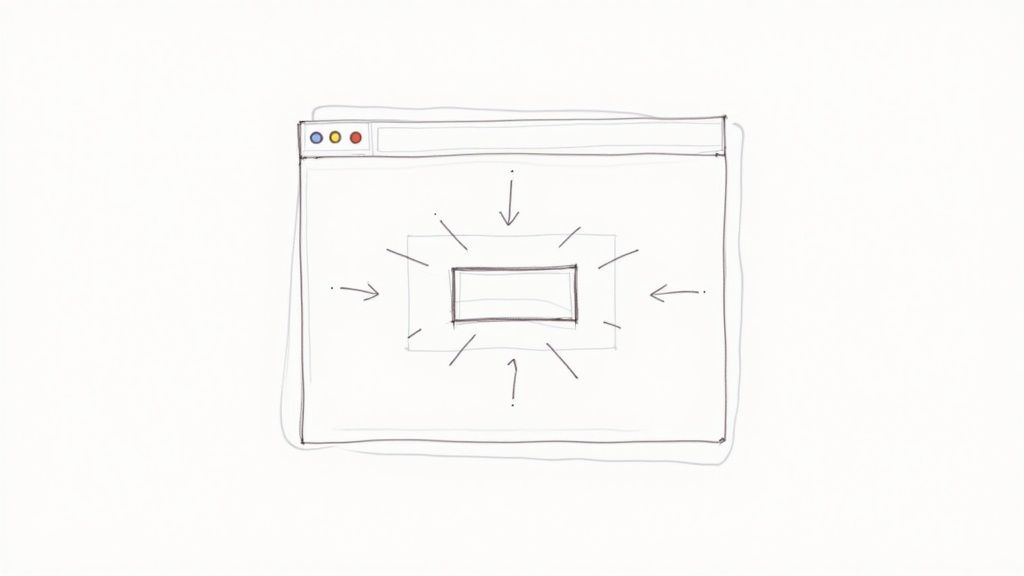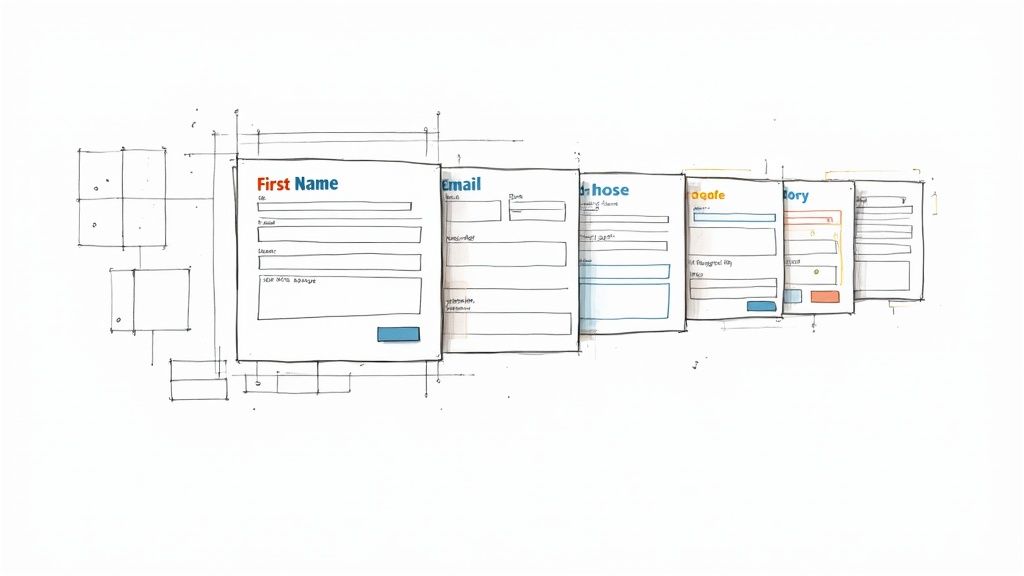
9 Lead Generation Best Practices for 2025
In today's competitive market, capturing high-quality leads requires more than just a contact form. Traditional strategies are becoming less effective, making it crucial to adopt a modern approach that prioritizes value, engagement, and personalization. This means moving beyond static content and embracing dynamic experiences, especially with tools like interactive video.
This guide delivers a comprehensive collection of actionable lead generation best practices designed to not just fill your pipeline but also to build lasting customer relationships. You will find nine powerful techniques, from crafting irresistible lead magnets and optimizing landing pages to implementing sophisticated lead scoring and leveraging in-video capture with platforms like Mindstamp.
Of course, a fundamental aspect of any effective lead generation strategy is ensuring a steady stream of visitors to your website. To learn more about driving initial visibility, explore various strategies for increasing website traffic to attract the right audience. Once they arrive, the tactics outlined here provide a complete roadmap to convert that traffic, elevate your marketing efforts, and drive measurable growth. Consider this your playbook for transforming passive viewers into qualified, engaged leads.
1. Create Compelling Lead Magnets
A lead magnet is a free, high-value resource you offer to prospects in exchange for their contact information, typically an email address. This is a foundational element of modern digital marketing because it provides immediate, tangible value that directly addresses a specific pain point or interest of your target audience. Instead of just asking for a subscription, you’re initiating a relationship built on a fair value exchange.

This strategy works because it instantly converts passive website visitors into actionable leads. It's the first step in nurturing them through your sales funnel. Think of HubSpot's extensive library of free marketing templates or Neil Patel's SEO analyzer tool; both solve an immediate problem for their ideal customer, making the decision to share contact details an easy one.
How to Implement This Strategy
To create a truly effective lead magnet, focus on specificity and immediate utility. It must be something your audience can consume or use quickly to see a benefit.
- Focus on a Specific Solution: Your lead magnet should solve a single, specific problem for a single, specific audience. A title like "The Ultimate 10-Point Checklist for Launching Your First Podcast" is far more compelling than "A Guide to Podcasting."
- Prioritize Professional Design: Use professional branding and a clean layout. A poorly designed PDF or a clunky tool will reflect negatively on your brand, diminishing the perceived value of your paid offerings.
- Test Different Formats: Don't limit yourself to PDFs. Experiment with checklists, video tutorials, exclusive webinars, interactive quizzes, or free tools. This is a crucial area where testing different lead generation best practices can reveal what resonates most with your audience.
- Include Clear Next Steps: Once someone downloads your resource, guide them on what to do next. This could be a link to a relevant blog post, an invitation to a webinar, or an introduction to your core product.
Key Insight: The best lead magnets offer a "quick win." They provide a sense of accomplishment and demonstrate your expertise, making leads more receptive to future communication and offers. For more inspiration, you can find examples of interactive lead capture forms on Mindstamp.com.
2. Optimize Landing Pages for Conversion
Landing page optimization is the process of creating a focused, single-purpose webpage designed to convert visitors into leads. These pages eliminate distractions like site navigation and competing offers, guiding visitors toward a single action through strategic design, compelling copy, and a frictionless user experience. This focus is what makes them such a powerful tool in any lead generation strategy.

This method works by matching the visitor's intent from an ad or link directly to a page that delivers on that specific promise. Think of Shopify's free trial pages or Zoom's webinar registration forms; they don't try to sell you anything else. They simply fulfill the visitor's immediate need, making the conversion path clear and easy, which is why platforms like Unbounce often see conversion rates of 15-25% on well-designed pages.
How to Implement This Strategy
A successful landing page is a masterclass in simplicity and persuasion. It should be built to remove friction and build trust simultaneously, making the decision to convert feel natural and logical.
- Focus on a Singular Goal: Your landing page must have one and only one conversion goal. Every element, from the headline to the CTA button, should support that single action.
- Keep Forms Minimal: Only ask for the information you absolutely need. For top-of-funnel leads, a name and email are often enough. Limiting forms to 3-5 fields drastically reduces friction.
- Write Benefit-Focused Copy: Instead of listing features, your headline and body copy must clearly articulate how the user will benefit. Answer the question "What's in it for me?" right away. To ensure your landing pages effectively convert leads, implement these 8 powerful landing page optimization tips for conversions.
- Build Trust and Credibility: Include social proof like customer testimonials, logos of well-known clients, or security badges. These elements reassure visitors that they are making a safe and smart choice.
Key Insight: The best landing pages function like a persuasive conversation with a single-minded focus. Remove every element that doesn't contribute to the conversion goal to maximize your lead generation best practices and achieve higher performance.
3. Implement Progressive Profiling
Progressive profiling is an intelligent lead generation technique that collects information from your prospects incrementally over multiple interactions. Instead of asking for a dozen details on the first form, you start with the basics (like name and email) and then ask for more specific data on subsequent visits or content downloads. This approach dramatically reduces initial form friction, encouraging more sign-ups.

This strategy is highly effective because it respects the user's time and builds a relationship based on gradual trust. Marketing automation platforms like HubSpot and Marketo pioneered this with "smart forms" that dynamically show new fields to returning visitors. For example, a first-time visitor might only see fields for name and email, while a returning lead might be asked for their company size or job title, enriching their profile without creating a barrier.
How to Implement This Strategy
To use progressive profiling effectively, you need a clear plan for what data you need and when to ask for it. This requires strategic thinking about your customer journey and sales cycle.
- Start with Minimal Fields: Your initial form should be as simple as possible, typically asking for only a name and email address. This maximizes initial conversions and gets leads into your system.
- Prioritize High-Value Information: Map out the key data points you need to qualify a lead, such as company name, role, or primary challenge. Introduce these questions one or two at a time in subsequent forms for new content offers.
- Use Conditional Logic: Employ smart forms that recognize returning visitors (via cookies) and present them with new questions. This ensures you never ask for the same information twice, creating a seamless user experience.
- Align Questions with Content: Ask for information that is relevant to the content being offered. If a lead is downloading a guide on B2B sales, asking for their company size is a logical next step.
Key Insight: Progressive profiling transforms lead generation from a single transaction into an ongoing conversation. It allows you to build a comprehensive lead profile over time, enabling highly personalized and effective nurturing campaigns that are far superior to generic follow-ups.
4. Leverage Social Proof and Testimonials
Social proof is the psychological concept that people conform to the actions of others, assuming those actions are the correct behavior for a given situation. In lead generation, this translates to using testimonials, reviews, case studies, and social indicators to build trust and credibility. When prospects see that others like them have had a positive experience with your brand, it reduces friction and validates their decision to convert.
This strategy is powerful because it addresses one of the biggest hurdles in marketing: skepticism. By showcasing authentic endorsements, you shift the narrative from "what we say about ourselves" to "what our happy customers say about us." Think of Amazon's pervasive customer reviews or Salesforce's detailed customer success stories; these elements are critical for building the confidence needed for a user to provide their information.
How to Implement This Strategy
Integrating social proof effectively requires more than just dropping a quote on your page. It needs to be authentic, relevant, and strategically placed to influence decision-making at critical moments.
- Be Specific and Authentic: Vague praise like "Great service!" is less impactful than a detailed testimonial. Use full names, job titles, and photos (with permission) to add legitimacy. The more specific the feedback, the more believable it becomes.
- Place Proof Near Conversion Points: Don't hide your best testimonials on a separate page. Place them directly beside your lead capture forms, pricing tables, or "Request a Demo" buttons to reinforce the value proposition right when it matters most.
- Use Quantifiable Results: The most compelling case studies and testimonials include hard numbers. "We increased our leads by 45% in one quarter" is far more persuasive than "We got more leads." This is one of the lead generation best practices that directly ties your solution to tangible ROI.
- Leverage Video Testimonials: A video testimonial can be significantly more engaging and persuasive than text. Seeing and hearing a real person share their success story builds a stronger emotional connection and is harder to fake, boosting its credibility.
Key Insight: Social proof works best when it's highly relevant. A testimonial from a customer in the same industry as your prospect is exponentially more powerful than a generic one. Tailor your displayed social proof to match the audience of each specific landing page.
5. Use Multi-Channel Lead Nurturing Campaigns
Once you’ve captured a lead, the conversation has just begun. Multi-channel lead nurturing is the practice of engaging prospects across various touchpoints, including email, social media, retargeting ads, and even interactive video. This comprehensive approach ensures your brand remains top-of-mind and guides leads through the sales funnel more effectively than relying on a single channel.
This strategy is powerful because prospects rarely stick to one platform. They might discover you on social media, download a lead magnet from your website, and then see a retargeting ad on a different site. By orchestrating a consistent and helpful presence across these channels, you create a seamless customer journey. This is a core component of the inbound marketing methodology popularized by companies like HubSpot, where value is delivered at every interaction, regardless of the platform.
How to Implement This Strategy
A successful multi-channel campaign requires careful planning and coordination to ensure your messaging is coherent and timely, not repetitive or annoying.
- Maintain Consistent Messaging: While the format may change, your core message and brand voice must remain consistent across all channels. A lead should have a unified brand experience whether they see a tweet, an email, or a video.
- Use Behavioral Triggers: Automate your nurturing based on user actions. If a lead watches 75% of a product demo video, trigger a follow-up email from a sales rep. If they visit a pricing page, show them a retargeting ad with a special offer.
- Create Channel-Specific Content: Adapt your content to fit the platform. A detailed guide works well for a blog post, but it should be repurposed into a short video for social media, a checklist for email, and concise ad copy for retargeting.
- Implement Attribution Tracking: Use tools to track which channels are most effective at moving leads from one stage to the next. This allows you to measure ROI and optimize your spending and effort for maximum impact.
Key Insight: The goal of multi-channel nurturing isn't to be everywhere at once, but to be in the right place at the right time with the right message. This relevance is what transforms a cold lead into a warm prospect. For more on guiding user actions within your content, see these tips for adding effective call-to-action buttons to your videos.
6. Implement Lead Scoring and Qualification Systems
Lead scoring is a systematic process of assigning points to leads to determine their sales readiness. Values are assigned based on a lead's demographics, firmographics, and engagement behavior, such as website visits, email opens, and content downloads. This allows your sales and marketing teams to prioritize efforts, focusing on prospects who are most likely to convert instead of treating all leads as equal.
This strategy is one of the most powerful lead generation best practices for scaling operations because it creates efficiency and alignment between marketing and sales. Instead of sales wasting time on unqualified leads, they receive a curated list of high-value prospects. Platforms like HubSpot and Salesforce use sophisticated scoring models to automatically rank leads, ensuring sales teams engage with the right person at the right time with the right message.
How to Implement This Strategy
A successful lead scoring system requires a clear definition of what constitutes a "qualified" lead and constant refinement based on real-world data.
- Define Your Ideal Customer Profile (ICP): Before assigning points, clearly document the attributes of your perfect customer. This includes industry, company size, job title, and geographic location. These attributes form the basis of your demographic scoring.
- Track Engagement Signals: Assign points for actions that indicate interest. A visit to your pricing page is more valuable than a blog post view. Similarly, watching an entire interactive product demo on a platform like Mindstamp signals higher intent than just visiting your homepage.
- Use Both Positive and Negative Scores: Award points for desired traits and actions, but also subtract points for negative signals. For example, a lead from a competitor, a student email address, or a long period of inactivity might receive a negative score.
- Establish a Handoff Threshold: Define the specific score at which a lead is considered "Marketing Qualified" (MQL) and should be passed to the sales team. This creates a clear, data-driven handoff process that prevents ambiguity.
Key Insight: The goal of lead scoring isn't just to rank leads, but to understand their journey. An effective system reveals which marketing activities generate the most qualified prospects, allowing you to optimize your strategy and budget for maximum impact. You can learn more about how Salesforce approaches this with their Einstein Lead Scoring system.
7. Create Interactive Content and Tools
Interactive content moves beyond passive consumption, actively involving your audience in a two-way exchange. This approach includes tools like calculators, quizzes, assessments, and interactive videos that provide immediate, personalized value. In return for this engaging experience, users are far more willing to provide their contact information, transforming a simple visit into a meaningful interaction.
This strategy is highly effective because it delivers a customized outcome directly related to the user's input. Think of HubSpot's Website Grader, which provides a personalized SEO report, or the viral personality quizzes from BuzzFeed. These tools don't just tell; they show and engage, capturing not only a lead but also valuable data about their needs and challenges. This makes them one of the most powerful lead generation best practices for modern marketers.
How to Implement This Strategy
The key to successful interactive content is to offer genuine utility in a simple, intuitive format. Your tool should feel less like a form and more like a helpful, personalized consultation.
- Solve a Specific Customer Problem: Design your tool to answer a pressing question for your audience. A mortgage calculator for a real estate firm or a "What's Your Marketing Style?" quiz for a digital agency are perfect examples.
- Deliver Immediate, Actionable Value: The results should be instantly available and provide a clear, tangible benefit or insight. Don't make users wait for an email; show them their score, report, or recommendation on the spot.
- Keep the Interaction Simple: Avoid complex interfaces or too many questions. The goal is to make participation easy and enjoyable. Use progressive profiling to gather more information over time rather than all at once.
- Personalize the Follow-Up: Use the data collected from the interaction to tailor your subsequent communications. If someone's quiz results indicate an interest in social media, send them resources related to that topic.
Key Insight: Interactive content transforms lead capture from a transactional request into a valuable service. By providing a personalized solution upfront, you build instant trust and gather rich data that allows for highly effective nurturing. To take this further, you can personalize your video content with interactive elements.
8. Optimize for Mobile Lead Generation
Mobile optimization is the practice of ensuring your landing pages, lead forms, and interactive content are designed to function flawlessly on smartphones and tablets. With Google's mobile-first indexing and a majority of web traffic now originating from mobile devices, a non-responsive experience is no longer an option. It's a fundamental requirement for capturing leads from an audience that is constantly on the go.
This strategy is crucial because a frustrating mobile user experience directly translates to lost leads. If a form is difficult to fill out, a page loads slowly, or buttons are too small to tap, potential customers will simply abandon the process. Think of the seamless mobile onboarding for apps like Uber or the streamlined lead generation forms integrated directly into LinkedIn and Instagram feeds; they prioritize speed and ease of use, making lead capture effortless for the user.
How to Implement This Strategy
To effectively optimize for mobile, your design philosophy must shift from "mobile-friendly" to "mobile-first." This means designing for the smallest screen and then adapting the experience for larger devices.
- Design for Touch: Use large, touch-friendly buttons and ensure form fields have ample spacing. This prevents accidental taps and reduces user frustration, a key consideration for modern lead generation best practices.
- Minimize Form Friction: Keep mobile forms as short as possible. Ask only for essential information. You can always gather more data later in the nurturing process.
- Prioritize Page Speed: Mobile users are impatient. Compress images, leverage browser caching, and minimize code to ensure your pages load almost instantly, even on slower cellular networks.
- Test Rigorously: Don't just assume your site works on mobile. Use browser developer tools and real devices to test your lead generation flows across various screen sizes, operating systems, and browsers.
Key Insight: A successful mobile lead generation strategy is built on speed and simplicity. Remove every possible point of friction between the user's initial interest and the form submission. The goal is to make providing their information feel like the easiest and most natural next step.
9. Implement Retargeting and Remarketing Campaigns
Retargeting is the practice of serving targeted ads to people who have already visited your website or interacted with your content but did not convert. By placing a small, unobtrusive pixel on your site, you can re-engage these "warm" prospects on other platforms like social media and across the web, keeping your brand top-of-mind and guiding them back to complete a desired action.
This strategy is highly effective because it focuses your ad spend on an audience that has already demonstrated interest in your brand. Instead of casting a wide net to find new prospects, you’re nurturing existing interest. Think of how Amazon shows you ads for a product you viewed but didn't buy; this persistent, relevant reminder significantly increases the likelihood of a future conversion and is one of the most powerful lead generation best practices.
How to Implement This Strategy
A successful retargeting campaign relies on segmentation and relevance. You must show the right message to the right person at the right time to avoid being intrusive.
- Segment Your Audience: Don't treat all visitors the same. Create separate audience segments based on behavior, such as visitors who viewed a specific product page, those who abandoned a cart, or users who watched a certain percentage of an interactive video.
- Craft Compelling Ad Creative: Your ads must be specific to the audience segment. If someone viewed your pricing page, show them an ad with a special offer or a testimonial. Use strong calls-to-action that align with their original intent.
- Set Frequency Caps: To avoid "ad fatigue" and annoyance, limit the number of times a single user sees your ad within a given period. Most platforms, like Google Ads and Meta, have settings for this.
- Exclude Converted Leads: Ensure you stop showing lead generation ads to people who have already converted. Wasting impressions on existing customers is inefficient and can create a poor user experience.
Key Insight: Retargeting bridges the gap between initial interest and final conversion. By personalizing the follow-up based on user behavior, you create a seamless journey that gently nudges prospects down the funnel, turning missed opportunities into valuable leads.
Lead Generation Best Practices Comparison
Putting Your Lead Generation Plan into Action
Mastering the art and science of lead generation is not a one-time project; it is a continuous cycle of strategic implementation, rigorous testing, and insightful adaptation. The nine comprehensive best practices detailed in this guide, from crafting irresistible lead magnets to launching sophisticated retargeting campaigns, provide a robust and modern framework. Following these guidelines will empower you to attract, engage, and convert your ideal customer profile with greater precision and efficiency.
A powerful theme connects these distinct strategies: a steadfast commitment to delivering genuine value and creating genuinely engaging user experiences. Passive content consumption is no longer enough to capture attention in a crowded digital landscape. The future of effective marketing lies in active participation, and this is where many of these lead generation best practices truly shine.
Key Takeaways for Sustainable Growth
As you move from reading to implementing, keep these core principles at the forefront of your strategy:
- Value First, Ask Second: Whether it’s a detailed guide, a helpful checklist, or an interactive tool, your primary goal should be to provide something so valuable that a prospect feels confident exchanging their contact information for it.
- Seamless Experience is Non-Negotiable: A high-friction process kills conversions. Ensure every step, from the landing page to the form submission, is optimized, mobile-friendly, and intuitive. Progressive profiling is a key tactic here, respecting the user's time by asking for information incrementally.
- Interaction Drives Conversion: The shift from static to interactive content is one of the most significant opportunities in modern lead generation. By embedding questions, personalization, and lead forms directly within your content, particularly in video, you transform passive viewers into active participants and qualified leads.
Your Actionable Next Steps
Feeling overwhelmed by the possibilities is natural. The key is to start small, build momentum, and scale what works. Don't try to implement all nine strategies at once.
- Conduct an Audit: Begin by evaluating your current lead generation efforts. Where are the biggest leaks in your funnel? Which of the best practices discussed here addresses your most significant weakness?
- Select One or Two Strategies: Choose the one or two practices that promise the highest impact for your business right now. For many, integrating interactive video or optimizing landing pages are excellent starting points with clear, measurable ROI.
- Define, Measure, and Iterate: Set clear KPIs for your new initiative. Track metrics like conversion rate, cost per lead, and lead quality. Use this data to refine your approach, test new variables, and continuously improve your results.
Ultimately, embracing these lead generation best practices is about more than just filling your pipeline. It’s about building a resilient, data-driven marketing engine that fosters authentic connections and drives sustainable business growth. The journey to mastery is ongoing, but with this framework, you are well-equipped to build a system that consistently delivers high-quality leads for years to come.
Ready to turn your video content into a lead generation powerhouse? See how Mindstamp makes it easy to add interactive forms, buttons, and personalized pathways directly into your videos. Start your free trial today and discover why a more engaging viewing experience leads to better, more qualified leads.
Get Started Now
Mindstamp is easy to use, incredibly capable, and supported by an amazing team. Join us!



Try Mindstamp Free










